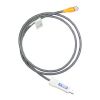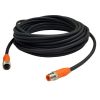Vaisala WSP152 Surge Protector
Features
- Designed to protect the USB connection of a PCconnected to the Vaisala WXT510 or WMT52
- Excellent three-stage, transient surge protection
- Tolerates up to 10 kA surge currrents
- Free ground shipping
- Expedited repair and warranty service
- Lifetime technical support
- More
Overview
The Vaisala WSP152 Surge Protector is a compact transient overvoltage suppressor designed for the protection of the USB connection of a PC connected to the Vaisala WXT520 or WMT52. The WSP152 is designed to protect the host PC against surges entering through the USB port. Please note that the USB connection of a PC is for indoor use only.
Mechanics
The Vaisala WSP152 Surge Protector offers three-stage protection against surge currents up to 10 kA that may enter through the USB cable or the port. The WSP152 has four channels, two of which are dedicated to power lines and two for data lines. Each channel uses a three-stage protection scheme as follows: first, there are discharge tubes, then voltage-dependent resistors (VDR), and finally, transient zener diodes. Between each stage, there are either series inductors or resistors.
Both differential and common mode protection is provided for each channel: across the wire pairs, against the operating voltage ground, and against the earth. The WSP152 also includes noise filtering against HF and RF interference.
Applications
Vaisala recommends using the WSP152 when USB cables are used for permanent connections. The surge protector is always recommended when there is an elevated risk of lightning strikes.
In The News
It’s Time to React to Water Quality: Proteus Multiparameter Probe aboard NexSens Buoy
Water quality monitoring is essential for safeguarding public health, protecting ecosystems, and ensuring the sustainability of water resources. Contaminants such as industrial pollutants, agricultural runoff, and sewage discharge can severely impact aquatic life and pose serious risks to human health if left unchecked. Traditionally, water quality monitoring has been a slow and labor-intensive process, requiring samples to be collected, transported to a lab, and analyzed—a process that can take days. However, with the advancement of real-time sensor technology, environmental agencies, researchers, and industries can now monitor water quality instantly.
Read MoreSafeguarding Communities with Real-Time Flood Monitoring in the City of Hazelwood
The City of Hazelwood is a suburb in St. Louis County, Missouri, home to around 25,500 people. Recently, the community has suffered increased flash flooding following severe storms, prompting the need for the installation of a flood monitoring system. In 2022, a NexSens X2 data logger was installed to monitor water level and rainfall in real-time, with the aim of reducing the loss of life and property as a result of extreme weather events. [caption id="attachment_39411" align="alignnone" width="940"] The latest flood event at Coldwater Creek, where the water level rose by 14 feet, exceeding the height of the X2 by three feet. The sensor can be seen behind the wall that usually contains the Creek.
Read MoreSave our Bogs! Culture, Conservation and Climate Action in Ireland’s Peatlands
Characterized by long-term accumulation under waterlogged conditions, peatlands exist on every continent and account for 3-4% of the global land surface . Small but mighty, these often overlooked wetland environments are estimated to hold as much as one-third of the world's organic carbon in their soil—twice the amount found in the entirety of the Earth's forest biomass. While healthy peatlands can trap and store carbon, regulate water, and provide important habitats for rare species, human alteration has disturbed peatland carbon and nitrogen cycles on a global scale. Approximately 12% of the world’s peatlands have been drained and degraded through conversion for agriculture, forestry, infrastructure development, and other uses.
Read More










